
The Isle of Portland is a tied island, 6 kilometres (4 mi) long by 2.7 kilometres (1.7 mi) wide, in the English Channel. The southern tip, Portland Bill lies 8 kilometres (5 mi) south of the resort of Weymouth, forming the southernmost point of the county of Dorset, England. A barrier beach called Chesil Beach joins Portland with mainland England. The A354 road passes down the Portland end of the beach and then over the Fleet Lagoon by bridge to the mainland. The population of Portland is 13,417.

Weymouth and Portland was a local government district and borough in Dorset, England. It consisted of the resort of Weymouth and the Isle of Portland, and includes the areas of Wyke Regis, Preston, Melcombe Regis, Upwey, Broadwey, Southill, Nottington, Westham, Radipole, Chiswell, Castletown, Fortuneswell, Weston, Southwell and Easton; the latter six being on the Isle of Portland.
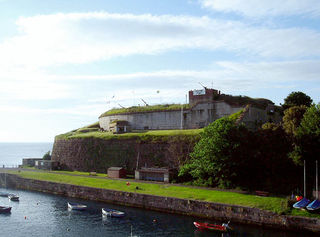
Nothe Fort is a fort in Weymouth, Dorset, England, situated at the end of the Nothe Peninsula, which juts eastwards from the town of Weymouth, and Weymouth Harbour, into the sea to the north of the ex-military Portland Harbour. The fort is located next to Nothe Gardens.

Sandsfoot Castle, also known historically as Weymouth Castle, is an artillery fort constructed by Henry VIII near Weymouth, Dorset. It formed part of the King's Device programme to protect against invasion from France and the Holy Roman Empire, and defended the Weymouth Bay anchorage. The stone castle had an octagonal gun platform, linked to a residential blockhouse, and was completed by 1542 at a cost of £3,887. Earthwork defences were built around the landward side of the castle, probably in 1623. Sandsfoot saw service during the English Civil War, when it was held by Parliament and Royalists in turn during the conflict. It survived the interregnum but, following Charles II's restoration to the throne, the fortress was withdrawn from military use in 1665.

Melcombe Regis is an area of Weymouth in Dorset, England.
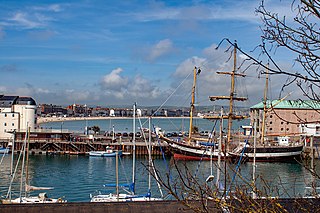
Weymouth is a seaside town and civil parish in the Dorset district, in the ceremonial county of Dorset, on the English Channel coast of England. Situated on a sheltered bay at the mouth of the River Wey, 11 kilometres (7 mi) south of the county town of Dorchester, Weymouth had a population of 53,427 in 2021. It is the third largest settlement in Dorset after Bournemouth and Poole. The greater Weymouth urban area has a population of 72,802.
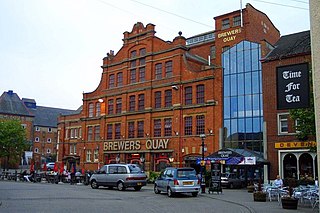
Brewers Quay is a converted Victorian brewery on the south side of Hope Square near the Old Harbour in Weymouth, Dorset, southern England. Much of the complex dates from 1903–04, when it was built as the Hope Brewery for John Groves & Sons Ltd. It was later taken over by Devenish Brewery in 1960 and opened in 1990 as an indoor shopping complex with around twenty specialty shops together with heritage and science exhibits, until it closed in 2010. From 2013-17, the building housed an antiques emporium. It currently awaits redevelopment.

Weymouth Museum is a museum in Weymouth, Dorset, England. Its permanent home is in Brewers Quay on the south side of Hope Square near Weymouth Harbour. However, due to redevelopment of the building, it is currently operating from a pop-up shop at 40b St Thomas Street in Weymouth.
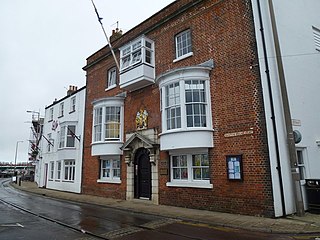
The Custom House is a former custom house at Weymouth, Dorset, England, operated by HM Customs to handle the trade of Weymouth Harbour. The building, which has origins to the late 18th century, has been Grade II listed since 1970.

Maiden Street Methodist Church is a former Methodist church in Weymouth, Dorset, England. It was built in 1866–67 to the designs of Foster and Wood of Bristol. The church was the victim of fire in 2002 and was subsequently replaced by the Weymouth Bay Methodist Church which opened in 2009. The church, which is a Grade II* listed building, remains a ruin and awaits redevelopment.

Weymouth Town Bridge is a lifting bascule bridge in Weymouth, Dorset, England, connecting the formerly separate boroughs of Weymouth and Melcombe Regis. The bridge can be lifted to allow boats access to the inner backwater of Weymouth Harbour, known as Weymouth Marina. The bridge, opened in 1930, is the sixth to have been built across the harbour since 1597 and has been Grade II Listed since 1997. Today, the hydraulically-operated bridge is raised every two hours, 363 days of the year.

St Mary's Church is a Church of England parish church in Weymouth, Dorset, England. Built of Portland stone in 1815–1817, the church has been described as having an "austere design in Palladian mode". It has been a Grade I listed building since 1953.

Belfield House is an 18th-century country house, located in Wyke Regis, Weymouth, Dorset, England. Built around 1775-80 of stone and yellow brick in a late classical design, the house has four Ionic columns at its entrance. It originally had its own extensive parkland of thirteen acres, however much of it was built-over during 20th-century development.

Stone Pier, also known as South Pier, is a pier located on the southern side of the entrance of Weymouth Harbour, in Dorset, England. It extends out from the Nothe Peninsula, which is the location of the Nothe Fort and Nothe Gardens.
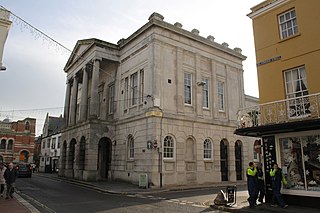
Weymouth Guildhall is a former guildhall at Weymouth, Dorset, England. The building, which was constructed in the 1830s, is a Grade II* listed building.

Alexandra Gardens Theatre was a theatre at Weymouth, Dorset, England. Originally known as the Alexandra Gardens Concert Hall, it was opened in 1924 and later converted into an amusement arcade in 1963. The building was destroyed by fire in 1993 and replaced with a new building which is still in use as the Electric Palace Amusement Arcade.

The Jubilee Clock Tower is a free-standing clock tower on the Esplanade of Weymouth, Dorset, England. It was built and erected in 1888 to commemorate the 1887 Golden Jubilee of Queen Victoria and became Grade II Listed in 1974. Historic England described the clock as being a "florid but characteristic enrichment to the sea-front" and "boldy coloured". It is built of cast and wrought-iron and set on a Portland stone base.

West Bay Methodist Church is a former Methodist chapel at West Bay, West Dorset, England. Opened in 1849, the chapel was locally known as "the chapel on the beach". It closed in 2007 and was transformed into the West Bay Discovery Centre in 2018. The former chapel has been Grade II listed since 1975.
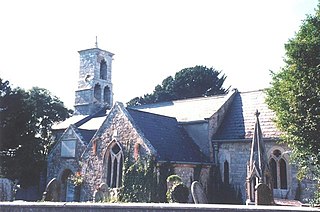
St Ann's Church is a Church of England parish church in Radipole, Weymouth, Dorset, England. The church dates to the 13th century, with later additions, and is a Grade II* listed building. Both the boundary wall of the churchyard and church room opposite are also Grade II listed.

Weymouth Bay Methodist Church is a Methodist church in Weymouth, Dorset, England. It was built in 2008–09 to replace the Maiden Street Methodist Church of 1866–1870 which was gutted by fire in 2002.




















